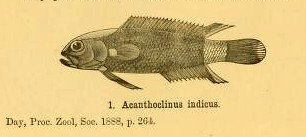 W
WThe Acanthoclininae is a subfamily of ray-finned fishes, one of two in the family Plesiopidae. They are characterised by the head being scaleless or nearly scaleless, a dorsal fin which has 17–26 spines and 2–6 soft rays, an anal fin having 7–16 spines and 2–6 soft rays while the pelvic fin has one spine and two soft rays. There are between one and four lateral lines, the number of vertebrae is between 26 and 35. They grow to a maximum length about 30 centimetres (12 in).
 W
WAcipenserinae is a subfamily of sturgeon containing two genera and 19 extant species.
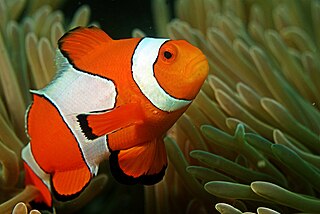 W
WClownfish or anemonefish are fishes from the subfamily Amphiprioninae in the family Pomacentridae. Thirty species are recognized: one in the genus Premnas, while the remaining are in the genus Amphiprion. In the wild, they all form symbiotic mutualisms with sea anemones. Depending on species, anemonefish are overall yellow, orange, or a reddish or blackish color, and many show white bars or patches. The largest can reach a length of 17 cm (6.7 in), while the smallest barely achieve 7–8 cm (2.8–3.1 in).
 W
WAnthias are members of the family Serranidae and make up the subfamily Anthiinae. Anthias make up a sizeable portion of the population of pink, orange, and yellow reef fishes seen swarming in most coral reef photography and film. The name Anthiidae is preoccupied by a subfamily of ground beetles in the family Carabidae created by Bonelli in 1813 and this grouping should be called the Anthiadinae. However, both the 5th Edition of Fishes of the World and Fishbase give the Serranid subfamily as "Anthiinae".
 W
WThe Apogoninae are the most species-rich and, of its shape, size, color and habitat, most diverse subfamily of cardinalfishes (Apogonidae). It can be found in coastal tropical and subtropical regions of the Indian Ocean, the eastern Pacific and the Atlantic, down to depths of 300 meters.
 W
WThe Doradidae are a family of catfishes also known as thorny catfishes, raphael catfishes or talking catfishes. These fish are native to South America, primarily the Amazon basin and the Guianas.
 W
WThe Astronotinae are a subfamily of cichlids from South America, where they are found in the Amazon, Orinoco, Paraná, and Paraguay River basins, and various rivers in the Guianas. The subfamily includes three genera, each with two species. Although in other classifications all three genera are placed in the subfamily Cichlinae with Astronotus being the only genus in the monogeneric tribe Astronotini of the subfamily Cichlinae and the other two genera being placed in the tribe Cichlini.
 W
WAtherininae is a subfamily of silversides from the family, Atherinidae, the Old World silversides.
 W
WAtherinomorinae is a subfamily of silversides from the family, Atherinidae, the Old World silversides.
 W
WBagre is a genus of sea catfishes found along the Atlantic and Pacific coasts of the Americas from southern North America to northern South America. Currently, four species are described:Bagre bagre (Linnaeus, 1766) Bagre marinus (Mitchill, 1815) Bagre panamensis (T. N. Gill, 1863) Bagre pinnimaculatus (Steindachner, 1877)
 W
WBlenniinae is one of two subfamilies in the combtooth blenny family Blenniidae, it is the smallest of the two subfamilies in the Blennidae with 16 genera and 95 species.
 W
WBrosmophycinae is a subfamily of the viviparous brotulas. They are divided from the subfamily Bythitinae by having the dorsal fin, caudal fin and anal fin all separate whereas they are joined in the Bythitinae. It is divided into the tribes Dinematichthyini and Brosmophycini, with the first having hardened genital claspers and the second soft genital claspers. A review in 2016 elevated the Dinematichthyini to the status of a family the Dinematichthyidae.
 W
WBythitinae is a subfamily of viviparous brotulas, one of the two subfamilies in the family Bythitidae. This subfamily is characterised by having the dorsal, caudal and anal fins combined. They are mostly found in temperate to tropical seas, from reefs to the benthopelagic zone, but some species from the North Atlantic Ocean occur in into Arctic waters.
 W
WCaranginae is a subfamily of ray-finned fish from the family Carangidae which consists of twenty genera and 103 species.
 W
WShrimpfish, also called razorfish, are five small species of marine fishes in the subfamily Centriscinae of the family Centriscidae. The species in the genera Aeoliscus and Centriscus are found in relatively shallow tropical parts of the Indo-Pacific, while the banded bellowsfish, which often is placed in the subfamily Macroramphosinae instead, is restricted to deeper southern oceans.
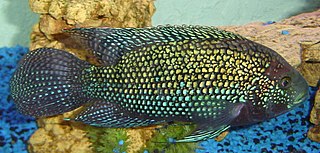 W
WThe Cichlasomatinae are a subfamily of cichlid fishes, including all ciclids native to the Greater Antilles, United States, Mexico and Central America, and many of the cichlids from South America. The subfamily Cichlasomatinae is often divided into two tribes: Cichlasomatini and Heroini, however some authorities classify these two tribes as part of the wider Neotropical and marginally Nearctic subfamily Cichlinae.
 W
WThe Cichlinae are a subfamily of fishes in the cichlid family, native to South America.
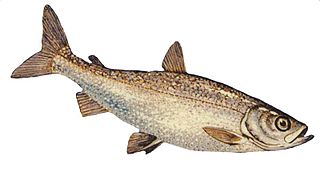 W
WThe freshwater whitefish are fishes of the subfamily Coregoninae, which contains whitefishes and ciscoes, and is one of three subfamilies in the salmon family Salmonidae. Apart from the subfamily Coregoninae, the family Salmonidae includes the salmon, trout, and char species of the subfamily Salmoninae, and grayling species of the subfamily Thymallinae. Freshwater whitefish are distributed mainly in relatively cool waters throughout the northern parts of the Northern Hemisphere.
 W
WCraterocephalinae is a subfamily of silversides from the family, Atherinidae, the Old World silversides. The majority of the species in this subfamily are freshwater fish, although some occur in brackish water. They are found in Australia and New Guinea.
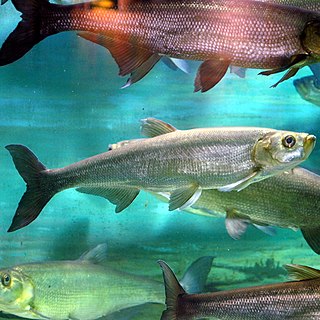 W
WThe Cultrinae are one of at least 13 subfamilies of cyprinid fish. It contains ten genera.
 W
WThe Cyprininae are one of at least 11 subfamilies of cyprinid fish. It contains three genera in its strictest definition but many more are included depending on which authority is defining it, especially if the Labeobarbinae is not considered to be a valid grouping.
 W
WThe danionins are a group of small minnow-type fish belonging to the family Cyprinidae. Members of this group are mostly in the genera Danio, Devario and Rasbora. They are primarily native to the fresh waters of South and Southeast Asia, with fewer species in Africa. Many species are brightly coloured and are available as aquarium fish worldwide. Danio species tend to have horizontal stripes, rows of spots, or vertical bars, and often have long barbels. Devario species tend to have vertical or horizontal bars, and short rudimentary barbels, if barbels are present at all. All danionins are egg scatterers and breed in the rainy season in the wild. They are carnivores living on insects and small crustaceans.
 W
WThe Halophryninae is a largely Old World subfamily of toadfish, part of the family Batrachoididae.
 W
WThe Hippocampinae are a subfamily of small marine fishes in the family Syngnathidae. Depending on the classification system used, it comprises either seahorses and pygmy pipehorses, or only seahorses.
 W
WHolocentrinae is a subfamily of Holocentridae containing 40 recognized species and one proposed species. Its members are typically known as squirrelfish and all are nocturnal. All three genera in the subfamily are found in the Atlantic and Holocentrus is restricted to this ocean. Most species in genera Neoniphon and Sargocentron are from the Indo-Pacific region and several of these occur in the Indian Ocean west of the southern tip of India.
 W
WThe Hypoptopomatinae are a subfamily of catfishes of the family Loricariidae, composed of 17 genera and approximately 80 species. This subfamily represents about one-tenth of all loricariid species.
 W
WThe Hypostominae are a subfamily of catfishes of the family Loricariidae. Most members of the subfamily are restricted to tropical and subtropical South America, but there are also several species in southern Central America. Hypostomus plecostomus, which is popular in the aquarium trade, has been introduced to several regions far from its native range.
 W
WLaviniinae is a subfamily of the freshwater fish family Leuciscidae, which contains the true minnows. Members of this family are known as western chubs or the western clade (WC) of minnows. As the name suggests, most members of this family are found in western North America aside from Chrosomus, which is found in eastern North America.
 W
WLeptobarbus is a genus of cyprinid fish that are native to freshwater habitats in Southeast Asia. They are important food fish. It is the only genus in the subfamily Leptobarbinae. Leptobarbus hoevenii or "sultan fish" migrate the fresh water rivers of Malaysia and travel at the surface in schools of 40-80 individuals at speeds of 0.48-1.08 km. Acid-soluble collagen (ASC) and pepsin-soluble collagen (PSC) were extracted from the muscles of selected cultured catfish, red tilapia, black tilapia, pangasius catfish, sultan fish and labyrinth fish, freshwater fishes that are widely consumed in Malaysia. The extracted yields for the tested species were higher for PSC as compared with ASC.
 W
WLeuciscinae is a subfamily of the freshwater fish family Cyprinidae, which contains the true minnows. Members of this subfamily are known as European minnows or the Old World (OW) clade of minnows. As the name suggests, most members of this family are found in Eurasia, aside from the golden shiner, which is found in eastern North America.
 W
WLoricariinae is a subfamily of the family Loricariidae of catfish. This subfamily is divided into two tribes and about 30 genera. They are mainly native to freshwater habitats in South America, but there are also several species in Panama and a single (Fonchiiichthys) in Costa Rica.
 W
WLuciocephalinae is a subfamily of the gourami family Osphronemidae. The members of this subfamily differ from the other groups within the gourami family by having a reduced number of rays supporting the branchiostegal membrane, five rather than six, and in the possession of a median process of the basioccipital which reaches the first vertebra and which has an attachment to the Baudelot’s ligament.
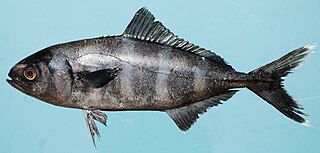 W
WNaucratinae is a subfamily of ray-finned fish from the family Carangidae which consists of five genera and 13 species.
 W
WOphidiinae is a subfamily of the cusk eel family Ophidiidae. The species in the subfamily are characterised by having their pelvic fins situated far forward on the body and supported by an forward orientated extension of the pelvic girdle, they lack barbels on the mouth and chin and they are covered in small cycloid scales arranged in horizontal or diagonal rows. Some species have a modified swim bladder and the anterior vertebrae which enables them to generate sounds. and some of these modifications are sexually dimorphic and make the fish capable of generating sound. They have two rays in each ventral fin and the caudal fin has 9 rays. Most species are benthic and occur on the continental shelf.
 W
WParatilapia is a genus of cichlids generally restricted to Madagascar. These are large, dark cichlids densely covered in light spots. An additional very poorly known species from the Congo River basin in mainland Africa is sometimes also placed in the genus, but this is highly questionable and arguably it is better placed in the "wastebasket genus" Haplochromis for the time being.
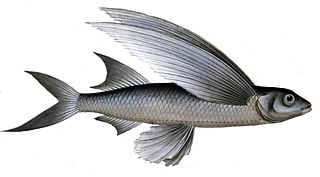 W
WParexocoetus is a genus of flying fishes. They are found in the tropical and subtropical western Atlantic and Indo-Pacific Oceans. It is the only genus in the subfamily Parexocoetinae which is unique amng the flying fishes in having a jaw which is very protrusible and having a joint situated between the cranium and the shoulder girdle which allows the head to be more manoeuvrable than in other lineages of this family.
 W
WPellonulinae is a subfamily of freshwater herrings belonging to the family Clupeidae.
 W
WPhallostethinae is a subfamily of fishes, one of two subfamilies in the family Phallostethidae, the priapumfishes. The species in this subfamily are characterised mainly by having highly protrusible jaws. The genus Neostethus appears to be the sister taxon to the other two genera in the subfamily. The species in the Phallostethinae are found in south-east Asia, the Malay Archipelago and the Philippines.
 W
WPhoxinus is a genus of freshwater fish in the family Leuciscidae of order Cypriniformes, and the only members of the subfamily Phoxininae, or Eurasian minnows. The type species is Phoxinus phoxinus. The other species in this genus are also commonly known as minnows. The name "minnow" was what early English fisherman used to describe "small and insignificant". The genus Phoxinus is found throughout Eurasia, and includes 21 known species. Previously, members of the North American genus Chrosomus were also believed to form part of this genus.
 W
WPlagopterinae is a subfamily of the freshwater fish family Leuciscidae, which contains the true minnows. Members of this family are known as creek chubs or the creek chub-plagopterin (CC-P) clade of minnows. All members of this family are found in North America, and it includes among the northernmost-distributed of all North American minnows, the lake chub.
 W
WPlesiopinae is one of two subfamilies in the family Plesiopidae, the longfins or roundheads.
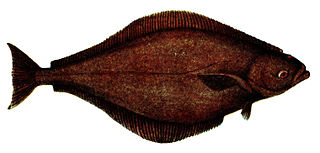 W
WPleuronectinae is a subfamily of fish in the family Pleuronectidae, comprising 27 genera and 62 extant species. Members of the subfamily are demersal carnivores that live in arctic and northern seas.
 W
WPoeciliinae is a subfamily of killifish from the family Poeciliidae which contains species from the Americas which are collectively known as the livebearers because many, but not all, of the species within the subfamily are ovoviviparous.
 W
WThe Poecilopsettidae are a family of flatfish in the order Pleuronectiformes, comprising three genera and 21 species. Species are typically demersal, living on marine bottoms at depths between 60 and 500 m in the Indo-Pacific and northwestern Atlantic; the deepest recorded occurrence is 1,636 m (5,367 ft) in the deepwater dab, Poecilopsetta beanii. Sizes range from 9 to 19 cm in length, though most species are usually under 15 cm (5.9 in) long. Diets consist of zoobenthos.
 W
WPogonichthyinae is a subfamily of the freshwater fish family Leuciscidae, which contains the true minnows. Members of this family are known as American minnows or the North American (NA) clade of minnows. As the name suggests, all members of this family are found in North America.
 W
WPomacentrinae is one of four subfamilies in the family Pomacentridae which includes the clownfishes and the damselfishes. It is the most diverse of the subfamilies in the Pomacentridae with around 21 genera and approximately 200 species.
 W
WPseudaspininae is a subfamily of the freshwater fish family Leuciscidae, which contains the true minnows. It is also known as the Far East Asian (FEA) clade of minnows. As the name suggests, all members of this family are found in East Asia.
 W
WPseudochrominae is a subfamily of ray-finned fishes, one of four subfamilies that make up the family Pseudochromidae, the species within the subfamily are commonly called dottybacks. They are small reef-associated marine fish which have an Indo-Pacific distribution.
 W
WThe Pseudocrenilabrinae are a subfamily in the cichlid family of fishes to which, according to a study from 2004, includes all the Middle Eastern and African cichlids with the exception of the unusual Heterochromis multidens and the Malagasy species. This subfamily includes more than 1,100 species. Previous authors recognized additional African subfamilies, e.g. the Tilapiinae of Hoedeman (1947), Tylochrominae of Poll (1986), or Boulengerochrominae of Tawil (2001).
 W
WThe Ptychochrominae are a subfamily in the cichlid family of fish. It includes about 14 species. They are restricted to lakes and rivers in Madagascar, and the majority are threatened. Most cichlid genera native to Madagascar are included in this subfamily; the only exceptions are Paretroplus and Paratilapia.
 W
WSalmonidae is a family of ray-finned fish, the only living family currently placed in the order Salmoniformes. It includes salmon, trout, chars, freshwater whitefishes, and graylings, which collectively are known as the salmonids. The Atlantic salmon and trout of the genus Salmo gives the family and order their names.
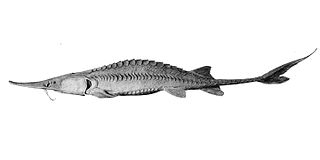 W
WScaphirhynchinae is a subfamily of sturgeon which includes two genera comprising a total of six species.Genus Scaphirhynchus Heckel, 1835 Scaphirhynchus albus (Forbes & R. E. Richardson, 1905) Scaphirhynchus platorynchus (Rafinesque, 1820) Scaphirhynchus suttkusi J. D. Williams & Clemmer, 1991 Genus Pseudoscaphirhynchus Nikolskii, 1900 Pseudoscaphirhynchus fedtschenkoi (Kessler, 1872) Pseudoscaphirhynchus hermanni (Kessler, 1877) Pseudoscaphirhynchus kaufmanni (Kessler, 1877)
 W
WScomberoidinae is a subfamily of ray-finned fish from the family Carangidae which consists of three genera and 10 species. The species in this subfamily have been given the common names leatherjacket and queenfish.
 W
WThe Scombrinae are a subfamily of ray-finned bony fishes in the family Scombridae. Of the 51 species in the Scombridae, 50 are in Scombrinae – with the sole exception being the butterfly kingfish, which is placed in the monospecific subfamily Gasterochismatinae.
 W
WSqualiobarbinae is a small subfamily of the carp and minnow family, Cyprinidae, which consists of three monotypic genera which have their natural distributions in eastern Asia. Two species, the grass carp and the black carp, have been introduced to other parts of the world for weed control and aquaculture. They are large cyprinids which are characterised by an enlarged subtemporal fossa, the palate articulating with the supraethmoid, an enlarged intercalar bone in the cranial vault and a divided levator posterior muscle.
 W
WSynbranchinae is a subfamily of swamp eel, consisting of three of the four genera in the family Synbranchidae. The remaining genus, the monotypic Macrotrema is the only one in the other subfamily Macrotreminae. The subfamily occurs in the Neotropics, Afrotropics and Asia.
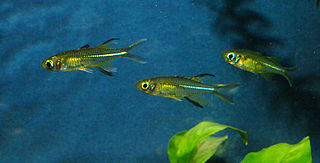 W
WThe Telmatherininae, the sail-fin silversides are a subfamily of atheriniform fish from the rainbowfish family, the Melanotaeniidae, inhabiting fresh and brackish water. All but the species Kalyptatherina helodes are restricted to the Indonesian island of Sulawesi, and most are found solely in the Malili Lake system, consisting of Matano and Towuti, and the small Lontoa (Wawantoa), Mahalona and Masapi.
 W
WTrachyrincinae is a subfamily of the family Macrouridae, also known as rattails. The subfamily contains two genera found in Atlantic, Indian and Pacific Ocean. These species lives in deep-water. These fishes have a long, narrow and sharply pointed snout. The chin barbel is present.